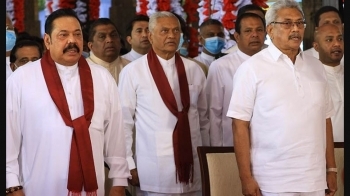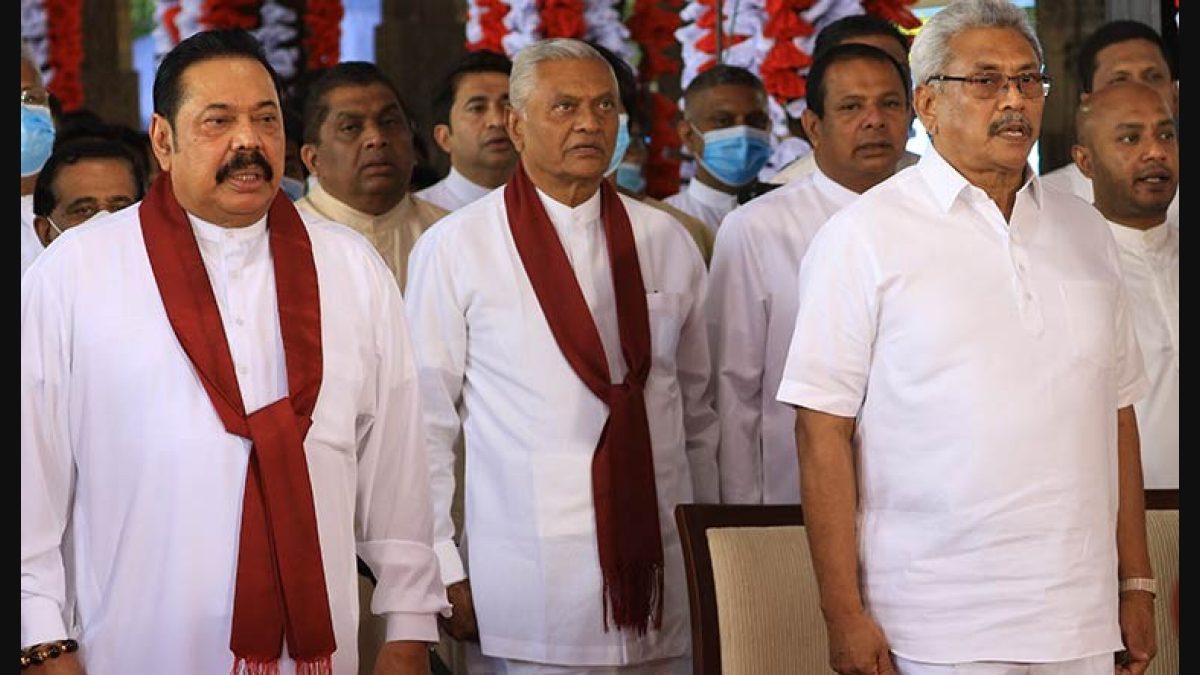
 A. J. Philip
A. J. Philip

The rise and growth of Hindutva in India have a lot of similarities to the rise and growth of Sinhala nationalism in Sri Lanka. Today, Sri Lanka is a basket case. The economic condition of the island nation is such that it does not have money to import ink and paper to conduct school and college examinations. Liberal financial and commodity assistance from India has helped Colombo to avert starvation and fleeing of people to the shores of India.
The new finance minister, Ali Sabry, who is the only Muslim to hold a ministerial post in the country, has the onerous task of negotiating a deal with the International Monetary Fund (IMF) to prevent an economic collapse. Mahinda Rajapaksa, who ruled the nation with a firm hand, is so hated that his younger brother and President Gotabaya Rajapaksa had to order the military to rescue him from his official residence, Temple Trees. Otherwise, he could have been lynched. His ancestral house was burnt by the protesters.
A cat is believed to have nine lives. Mahinda Rajapaksa seems to have many more. The appointment of Ranil Wickremesinghe, a person who could never complete his term as prime minister and who was roundly defeated in his own constituency in the last election, as his successor is yet another attempt to keep the country under the Rajapaksa clan’s control. Whether he succeeds or not, there is no doubt that Sinhala nationalism has done enough damage to the nation.
It was VD Savarkar’s book titled ‘Hindutva’ which laid the foundation for Hindutva, a militant form of Hinduism. The setting up of the RSS in 1924 by Dr KB Hedgewar was with a view to uniting the Hindu society under the saffron flag. That is why the RSS founder withdrew from the freedom struggle, as he felt that Hindu energy should not be dissipated against the British.
If today the BJP is in power, it is because of the silent and not-so-silent work that the RSS cadres have been doing for nearly a century. MS Golwalkar, who succeeded Hedgewar as the supreme commander of the RSS, had in his books like ‘Bunch of Thoughts’ described the scenario when India became a Hindu theocratic nation.
Neither the BJP, nor the RSS has repudiated Golwalkar’s theories and as such they can be considered as the foundational principles of the RSS that has umbilical connections with an assortment of organisations. During my younger days, pictures of Lord Ram always had Sita beside Him. Hanuman was also part of the iconography. Ram was the personification of maryada or righteousness.
The picture of Ram that the Sangh Parivar popularises shows Him in a battle-ready state, wielding the bow and the arrow. Have you ever seen a picture or statue of Lord Buddha in an aggressive posture? He was the enlightened and the compassionate, who did not want to disappoint a poor person, who gave him stale pork as food, ate it and died of food poisoning.
Just as the beatific Ram has no use for the protagonists of Hindutva, the Sri Lankan Buddhist nationalists have no use for Buddha, the Learned. What they practise is known as Theravada Buddhism. The text they consider sacred is the Mahavamsa or the Great Chronicle, written in Pali in the sixth century.
The text describes Sri Lanka as the Promised Land of the Buddhists like Israel is the Promised Land of the Jews. Ram defeated Ravana in Valmiki’s Ramayana which became popular in North India when it was translated into the local language by Tulsidas around the time Babri Masjid was built in Ayodhya.
Similarly, the Sinhala nationalists do not see Lord Buddha as the embodiment of peace. He is projected as the valiant who would brook no opposition. He is believed to have visited Sri Lanka thrice and it was to convert the largest island in the Indian Ocean into an abode of the Buddhists.
The Mahavamsa describes in detail the exploits of Dutugamunu the Great, the warrior king of the Sinhalese. He is believed to have reigned from 161 BC to 137 BC. “He is renowned for reuniting the whole island of Sri Lanka by defeating and overthrowing Elara, the usurping Tamil prince from the Indian Chola Kingdom, who had invaded the Anuradhapura kingdom in 205 BC.
“Dutugamunu also expanded and beautified the city of Anuradhapura and projected the power of his native Rajarata region across the island of Sri Lanka”. There are many myths and legends about the King. They are a source of inspiration for the Sinhala nationalists.
Just as the state of Ayodhya under Lord Ram was considered the ideal state, the state under Dutugamunu was considered blemish-less.
Just like Savarkar who redefined Hinduism making it muscular, Angarika Dharmapala, who lived in the 19th Century, gave a new dimension to Sri Lankan Buddhism. He campaigned for the sovereignty of the Sinhalese. He was decidedly against Christians and Muslims and believed that Sri Lanka’s redemption lay in making Sri Lanka a homogenous state by the Sinhalese, for the Sinhalese and of the Sinhalese. Something like the Hindi-Hindu-Hindustan slogan that writer Sashi Tharoor referred to in his article in a Malayalam daily (May 13)! He can be called the father of Sinhala nationalism.
Just as the protagonists of Hindutva want Muslims and Christians as second-class citizens if they do not merge themselves into the Hindu mass, the Sinhala nationalists find no place for the Tamils or the other minorities in the country. In fact, in the sacred text I referred to, the Tamils are not even considered humans. Rather they are beasts!
It is like Ram encountering the Rakshasas (demons) during his 14-year exile. Extant understanding is that the Rakshasas were actually Dravidians, one of whose greatest rulers was Mahabali. Angarika Dharmapala and his followers could not reconcile themselves to the fact that the Tamils enjoyed certain status during the British period.
Just as the Bengalis and the Menons of British-administered Malabar enjoyed an upper hand during the British regime, throwing up bureaucrats like VP Menon and KPS Menon, Tamils had a presence in the Sri Lankan bureaucracy. The Sinhala nationalists resented it.
They were also against Tamil as another national language. Like the Pakistanis who did not want Bengali as the official language of what was then East Pakistan and what is now Bangladesh. In India, Urdu, a great language, has been reduced to a Muslim language and it is on its deathbed. Muslims themselves know that there is no future for their children if they study Urdu, instead of Hindi that Home Minister Amit Shah wants every citizen to speak, though it is a language created by the British officials and Christian missionaries.
One of the first things that the Sinhalas did after Sri Lanka attained independence in 1948 was to bring forward the Citizenship Act. Remember the agitation in India on the amended citizenship law! In one stroke of the pen, millions of Tamils in Sri Lanka became stateless. The adherents of Hindutva took their cue from this Act to demand expulsion of the so-called non-Assamese from Assam. What is forgotten is that many of them were encouraged to migrate to Assam to work in the tea gardens when the undivided Bengal was a part of united India.
Gopalkrishna Gandhi is a former diplomat and former Governor of West Bengal. He served two terms in Sri Lanka, the second time as Indian Ambassador. He wrote a novel Saranam, which I reviewed when it appeared in the eighties. The story is about the problems of the Tamils who suddenly became stateless in the land where they were born. He showed his mettle as a writer. It was at once a very touching novel. The irony is that the Sinhalese are also originally from India like the Tamils.
Today when the BJP leaders say that Bangladeshis infiltrate into Assam, people laugh because the rate of growth of Bangladesh is higher than that of India. More important, on all indices of growth like female literacy, infant mortality and mothers’ mortality, Bangladeshi women are ahead of their Assamese counterparts.
The Sinhalese struck again when it introduced a Sinhala Only Act denying Tamil any status. No language can grow without state support. The decision pushed the Tamils to the edges and there was resentment. The protest soon took the shape of Tamil nationalism demanding a separate Tamil Eelam or state. The Liberation Tigers of Tamil Eelam (LTTE) began to represent the Tamils.
What ensued was a fight that had few parallels. Finally, the Tigers, as the LTTE cadres led by Velupillai Prabhakaran were called, were eliminated using means that were as questionable as the terrorist activities of the Tigers. No consideration for Prabhakaran’s son Balachandran’s age —11 — was given when he was shot. The military campaign was led by the present president.
Sri Lanka could not prevent a vote in an international human rights body which found that the human rights violations at the hands of the Sri Lankan army could not be covered up. As the Sinhalese believe that the Tamil question was settled “once and for all”, the persecution of the Muslims began.
They started a campaign to end the presence of the Muslims in agricultural and fisheries sectors. The campaign in Karnataka against Muslims monopolising the mango trade could have been inspired by what the Sinhalese did in Sri Lanka. The fact of the matter is that the mango cultivators are mostly Hindus and they sell their crop to those who pay them the highest price. They do not look at the religion of the buyer.
It was not for no reason that former Kerala MLA PC George in his hate speech wanted Hindus to boycott Muslim restaurants. The idea is to push the Muslims to the margins so that they do not have any economic wherewithal. This strategy was first tried out in Sri Lanka.
The idea for the Sangh Parivar’s campaign against the Hijab that forced thousands of Muslim girls from appearing in school examination in Karnataka was also drawn from the Sinhalese who banned the garment. And when Covid-19 struck the nation like the rest of the world, the government banned all burials forcing Muslims to cremate their bodies. After a year or so, the government had to allow burials following protests from international bodies.
The series of bomb blasts in 2019 provided the Sinhala nationalists an opportunity to portray Muslims as terrorists. The anti-terrorism laws were used almost exclusively against Muslims, while the activities of the Bodu Bak Sena (BBS) which resembles those of a three-letter worded organisation in India were condoned. Christians also did not go unscathed.
Evangelical Christians had to face persecution while Cardinal Malcolm Ranjith’s support for Buddhist theocracy, instead of secularism, insulated the Catholic Church to some extent from aggression. All this had a deleterious effect on tourism which was the mainstay of Sri Lanka. The negative publicity the nation received reduced the tourist arrivals to a fraction of what it was before Covid struck.
Coupled with this were the vainglorious projects Mahinda Rajapaksa initiated like the construction of an airport, touted as Sri Lanka’s first green airport. Alas, the few airlines which started flights found that there were no passengers. Today the Mattala Rajapaksa International Airport (MRIA) is described as “a white elephant with a very small catchment area” where nobody flies.
What has Sinhala nationalism achieved? Civil strife and economic mismanagement have brought the country to a standstill. Mahinda Rajapaksa was the most popular leader Sri Lanka has ever seen. Today he is the most hated figure. Hopefully, the Sri Lankans have realised that excessive nationalism does not redound to the credit of any nation. When will those who believe that India’s redemption lies in dumping the minorities in the Bay of Bengal realise this bitter truth?
ajphilip@gmail.com